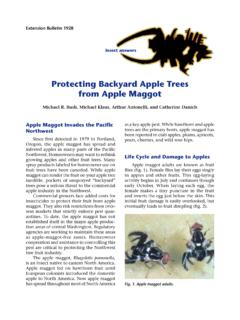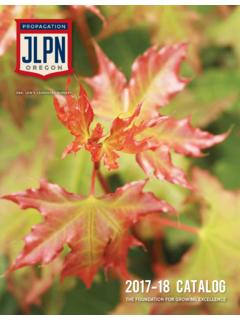Transcription of NATIVE PLANT FIELD GUIDE - The Wild Garden
1 NATIVE PLANT . FIELD GUIDE . Revised March 2012. Hansen's Northwest NATIVE PLANT Database Foreword Once upon a time, there was a very kind older gentleman who loved NATIVE plants . He lived in the Pacific northwest, so plants from this area were his focus. As a young lad, his grandfather showed him flowers and bushes and trees, the sweet taste of huckleberries and strawberries, the smell of Giant Sequoias, Incense Cedars, Junipers, pines and fir trees. He saw hummingbirds poking Honeysuckles and Columbines. He wandered the woods and discovered trillium. When he grew up, he still loved NATIVE plants --they were his passion. He built a Garden of natives and then built a nursery so he could grow lots of plants and teach gardeners about them.
2 He knew that alien plants and hybrids did not usually live peacefully with natives . In fact, most of them are fierce enemies, not well behaved, indeed, they crowd out and overtake natives . He wanted to share his information so he built a website. It had a front page, a page of plants on sale, and a page on how to PLANT natives . But he wanted more, lots more. So he asked for help. I volunteered and he began describing what he wanted his website to do, what it should look like, what it should say. He shared with me his dream of making his website so full of information, so inspiring, so educational that it would be the most important source of NATIVE PLANT lore on the internet, serving the entire world. Some years ago, this amazing man, Wally Hansen, passed on to the heavenly Garden .
3 Working with Diana Hansen-Young, Wally's daughter, we picked up the pieces. The nursery closed in 2010. Diana bequeathed the website and the huge library of photos to me, and I gladly took on the mantle of keeping Wally's dream alive. I hope to fulfill that dream some day. This FIELD GUIDE of plants NATIVE to the northwest came from a request by one of our readers. He sent me an email asking if the printable catalog was still around--it was no longer on the website. The way he described how useful the catalog was convinced me to make an up to date FIELD GUIDE that can be printed. This is the first edition. It will be revised periodically as needed. My sincere thanks to Doris Svendsen and Jim Roush for requesting this GUIDE .
4 See their booth at Vancouver Farmers Market. It's open Saturday and Sunday now through October. Jennifer Rehm Webmaster for The Wild Garden : Hansen's Northwest NATIVE PLANT Database contact: The Wild Garden : Hansen's Northwest NATIVE PLANT Database Page 2. The Oak and the Rose by Shel Silverstein An oak tree and a rosebush grew, Young and green together, Talking the talk of growing things- Wind and water and weather. And while the rosebush sweetly bloomed The oak tree grew so high That now it spoke of newer things- Eagles, mountain peaks and sky. I guess you think you're pretty great, The rose was heard to cry, Screaming as loud as it possibly could To the treetop in the sky. And now you have no time for flower talk, Now that you've grown so tall.
5 It's not so much that I've grown, said the tree, It's just that you've stayed so small. The Wild Garden : Hansen's Northwest NATIVE PLANT Database Page 3. Western Redbud --Susan Taylor Brown spring unleashed, it blooms pink kisses flirt with the sun Kool-Aid explosion The Wild Garden : Hansen's Northwest NATIVE PLANT Database Page 4. CONTENTS. Perennials .. 6. Ferns .. 24. Shrubs .. 26. Trees .. 44. A Garden near Salem, Oregon, belongs to a vibrant, active 90 year old woman. Over the years, she has planted hundreds of natives and transformed a common ordinary landscape to a wonderful woodland paradise. This is just one tiny piece of her Garden . Yellow trillium, wild flag, meadow rue, sweet woodruff, all in this small space.
6 In other areas of her yard, she has ferns, bleeding heart, NATIVE berries, an oak tree, some maples. She be- gan by planting just three plants and added to them each year. Some plants came unannounced, the work of local wildlife, I. assume. The lady of this Garden is unflappable. She knows her Garden is a joint effort--she's in cahoots with nature. It does take a village after all. The Wild Garden : Hansen's Northwest NATIVE PLANT Database Page 5. PERENNIALS. Achillea millefolium (Milfoil, Yarrow). Yarrow is an aromatic perennial herb known to most of us for its medicinal qualities. Present day uses are centered more on external injuries. Known as a styptic to stop bleeding, an astrin- gent and anti-inflammatory to sooth, and antiseptic to cleanse, it is no wonder it is a staple of the herb Garden .
7 It is also known for its ability to repel insects, which is beneficial to surrounding plants . The tall 1-3' flowers are white, rounded to flat umbels that may be tinged with pink or yellow and appear from Spring through Fall. The name millefolium means a thousand leaves and refers to the numerous small leaves, which give this PLANT its ferny appearance. Yarrow has naturalized throughout the North- ern Hemisphere but has Eurasian origins. It grows favorably in USDA zones 1-11 and most situations except deep shade and in areas containing standing water. Yarrow spreads quickly by rhizomes and forms dense mattes making it a good choice for reducing soil erosion on slopes and hillsides .Achlys triphylla (Vanilla Leaf). A beautiful PLANT that spreads quickly by rhizomes to carpet the shady understory.
8 The large, clover like leaves have fluttering scallops along the edges. Tiny white flowers form on the on thin, erect stalks. Dried leaves smell heavenly, like vanilla, and are said to repel insects. They remain on the PLANT as skel- etons throughout the winter and are as delicate as fairy wings. Vanilla Leaf is found from BC to northern California and is hardy from USDA zones 7-9. It prefers shaded, moist sites with some shade. It is an excellent companion to the delicate Lady fern (Athyrium filix-femina), and fits perfectly in the understory of Thimbleberry or Salmonberry (Rubus parvifloris or spectabilis). or even the Western Azalea (Rhododendron occidentale). Allium acuminatum (Hooker's Onion, Taper Tip Onion). A wild onion found mainly in the Western states from British Columbia to California as well as regions of Idaho and Utah.
9 At first glance, this allium looks much like other wild onions; but there are some differences. It is found in clusters and the grass-like leaves wither before it blooms. The flowers of Hooker's Onion are usually bright pink but can be white on occasion and are have tepals that are turned upward. All parts of the PLANT have a classic onion odor and were occasionally used as a food source for coastal Indians. Taper tip onion bulbs can be planted in either Spring or Fall in a dry open sunny location. They will tolerate some moisture, providing the soil is well drained; but are happiest in a dry habitat. They are impor- tant in habitat restoration and for aesthetic purposes in USDA. zones 3-9. The Wild Garden : Hansen's Northwest NATIVE PLANT Database Page 6.
10 Allium cernuum (Nodding Onion). As the name implies, the pink to rose flower clusters of this onion nod downward like little lanterns. Very widely distributed, growing across United States. In Pacific Northwest, may be found at lower elevations in dry open woodlands and along sandy coastal bluffs. The grassy leaves of this onion remain green throughout flowering. The onion odor is so strong that NATIVE Americans once thought them to be unpalatable, but once roasted, they found them perfect for flavoring wild fish and game and soon became a treat at harvest time. To assure that they are an edible onion, always check for the onion odor;. if it is not there, do not eat them. Considered a meadow onion, they do best with moisture in USDA zones 3-10.



